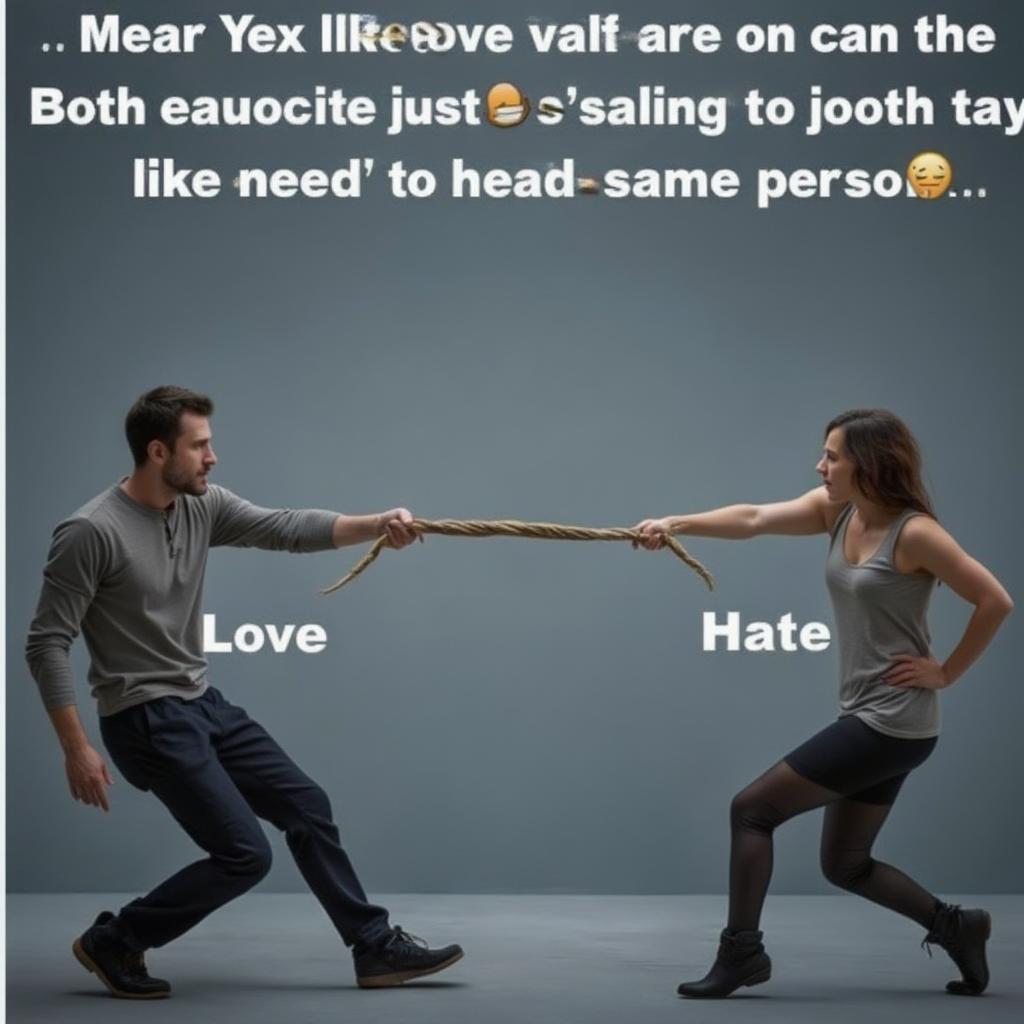It’s a complex question that many of us grapple with: Can You Love And Hate Someone At The Same Time? The short answer is: absolutely. This seemingly contradictory emotional experience is more common than you might think, and understanding it can be key to navigating complicated relationships.
The Push and Pull of Love and Hate
Feeling both love and hate towards someone can be intensely confusing. It’s like being caught in a constant tug-of-war between opposing forces. One moment you’re filled with warmth and affection, the next you’re consumed by resentment and frustration. This emotional rollercoaster often arises in close relationships, such as with family members, romantic partners, or even close friends. These are the people we invest the most in emotionally, creating a fertile ground for both deep love and intense negative feelings.
Understanding the Roots of Ambivalent Feelings
Why do these conflicting emotions coexist? Often, love and hate stem from the same source: a deep emotional connection. When someone holds significant importance in our lives, their actions and words carry more weight. Their positive qualities can inspire love and admiration, while their negative traits or behaviors can trigger hurt and resentment, leading to feelings of hate.
 Tug of War Representing Love and Hate
Tug of War Representing Love and Hate
Is it Normal to Feel Love and Hate?
Absolutely. Experiencing ambivalent feelings, especially in intense relationships, is a normal part of the human experience. It’s a testament to the complexity of human emotions and the multifaceted nature of our bonds with others. It doesn’t mean you’re a bad person or that the relationship is doomed. Rather, it signals a need for deeper exploration and understanding of the dynamics at play.
Recognizing the Signs of Love and Hate
Recognizing the signs of simultaneous love and hate can be the first step towards managing these complex emotions. These signs can manifest in various ways, including fluctuating between idealization and devaluation of the person, experiencing intense emotional reactivity to their actions, and feeling conflicted about maintaining the relationship.
Navigating the Complexities of Love and Hate
Navigating these conflicting emotions requires introspection and, often, professional guidance. Therapy can provide a safe space to explore the underlying causes of these feelings, develop coping mechanisms for managing emotional reactivity, and learn strategies for setting healthy boundaries.
Strategies for Managing Conflicting Emotions
Several strategies can help you manage the complexities of loving and hating someone simultaneously. Honest communication with the person involved, if appropriate, can help address underlying issues. Focusing on self-care, practicing mindfulness, and seeking support from trusted friends or family can also provide valuable emotional grounding.
- Communication: Open and honest communication can sometimes help resolve underlying issues contributing to the conflict.
- Boundaries: Establishing healthy boundaries can protect your emotional well-being.
- Self-reflection: Understanding your own emotional triggers and responses is crucial.
- Professional help: A therapist can offer guidance and support in navigating these complex emotions.
“Ambivalence in relationships is often a sign of unresolved issues, not necessarily a lack of love,” says Dr. Emily Carter, a renowned relationship psychologist. “Addressing these issues can pave the way for healthier, more fulfilling connections.”
Conclusion: Embracing the Complexity of Human Emotions
Can you love and hate someone at the same time? Yes, and it’s a testament to the depth and complexity of human emotions. While challenging, navigating these feelings can be an opportunity for growth and deeper understanding of yourself and your relationships. Remember, seeking professional guidance is a sign of strength, not weakness. It can empower you to manage these complex emotions effectively and build healthier, more fulfilling connections.
FAQ
- Is it unhealthy to feel love and hate for someone? Not necessarily. It’s a common human experience, especially in close relationships.
- How can I stop feeling this way? Exploring the root causes of these feelings through self-reflection or therapy can be helpful.
- Can these feelings coexist long-term? Yes, but managing them effectively is key to maintaining a healthy relationship.
- Should I tell the person I love and hate them? This depends on the specific relationship dynamics and individual circumstances. Consider the potential consequences and seek professional advice if needed.
- Is this a sign of a toxic relationship? Not always, but it can be. If these feelings are causing significant distress or dysfunction, it’s important to evaluate the health of the relationship.
- What if the person I feel this way about is a family member? Family dynamics can be particularly complex. Therapy can offer specific guidance for navigating these situations.
- Can love and hate eventually turn into just one emotion? Yes, with time and work, the ambivalent feelings can shift.
For further information and support on relationship issues, explore other articles on our website or reach out to our support team.
If you need support, please contact us at Email: contact@daiduongtranhba.com or visit our office at Michigan Ave, Suite 3100, Chicago, IL 60611, USA. We have a 24/7 customer support team.

